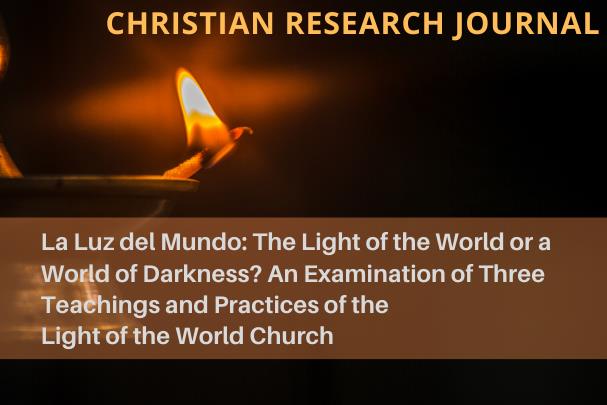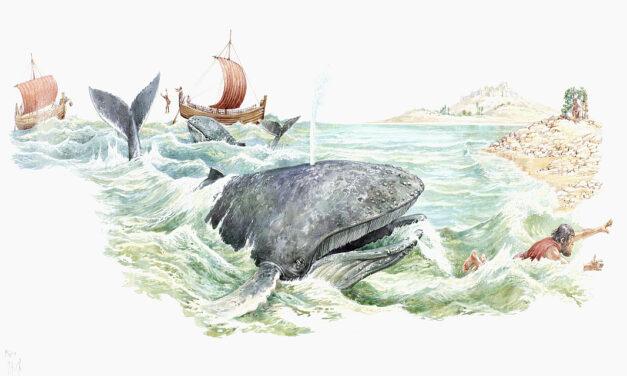This is an online-exclusive from the Christian Research Journal. For further information or to subscribe to the Christian Research Journal please click here.
When you to subscribe to the JOURNAL ,you join the team of print subscribers whose paid subscriptions help provide the resources at equip.org that minister to people worldwide. These resources include our free online-exclusive articles, such as this review, as well as our free Postmodern Realities podcast.
Another way you can support keeping our resources free is by leaving us a tip. A tip is just a small amount, like $3 or $5, which is the cost for some of a latte, lunch out, or coffee drink. To leave a tip, click here.
NOTES
- La Luz del Mundo [The Light of the World], “Somos [We Are],” Official Site, Qué es la Luz del Mundo? [What is The Light of the World?], last modified 2019, accessed September 14, 2019, http://www.lldm.org/Que-Es-La-Luz-Del-Mundo.html.
- La Luz del Mundo [The Light of the World], “Objetivos [Objectives],” Official Site, Qué es la Luz del Mundo? [What is The Light of the World?], last modified 2019, accessed September 14, 2019, http://www.lldm.org/Que-Es-La-Luz-Del-Mundo.html.
- See also “Fundacion de La Iglesia,” Iglesia del Dios Vivo Columna y Apoyo de la Verdad, La Luz del Mundo, 2010, archived October 15, 2013, Internet Archive, accessed January 17, 2020, https://web.archive.org/web/20131015151100/http://www.lldm.org/2007/fundacion.html.
- La Luz del Mundo [The Light of the World], “Inicia el Resurgimiento de la Iglesia de Cristo [The Resurgence of the Church of Christ Begins],” Official Site, Historia de la Iglesia La Luz del Mundo [History of The Light of the World Church], last modified 2019, accessed September 14, 2019, http://www.lldm.org/Historia.html.
- La Luz del Mundo, “Inicia el Resurgimiento de la Iglesia de Cristo.”
- The Apostolic Letters are a compilation of writings that the different apostle-leaders have made, which may contain the basis of their beliefs. Unfortunately, these writings are not completely available to the general public. I emailed TLOW for access, I have had no response so far.
- The Westminster Shorter Catechism, The Westminster Presbyterian, accessed January 20, 2020, http://www.westminsterconfession.org/confessional-standards/the-westminster-shorter-catechism.php.
- Unless noted otherwise, all Scripture quotations are taken from the English Standard Version.
- Eusebius, “Book IV, Bishops Writings and Martyrdoms, Sec. XXIII,” in Eusebius, The Church History, trans. Paul L Maier (Grand Rapids: Kregel Publications, 2007), 22–23.
- Niceno-Constantinopolitan Creed, AD 381. The Arians contended that Jesus is of a similar nature or essence [homoiousios], not the same nature or essence [homoousios], with the Father.
- La Luz del Mundo [The Light of the World], “¿Cuáles son Nuestros Principios Religiosos? [Which Are Our Religious Principles?],” Official Site, Qué es la Luz del Mundo? [What is The Light of the World?], last modified 2019, accessed September 14, 2019, http://www.lldm.org/Que-Es-La-Luz-Del-Mundo.html.
- Original Spanish: “A Dios se le adora porque a Él pertenece la adoración, a Jesucristo por obediencia…Dios autoriza la adoración a Su unigénito porque viene de Él” Ministerio Internacional de Ortodoxia de La Luz del Mundo, “La Verdadera Adoración [True Worship] on Temario Santa Convocación 2016 [2016 Holy Convocation Subject List]” (Berea Internacional, June 15, 2016), author’s translation.
- The first part of the sentence states that adoration is due to God alone, relating the subject of worship to the being of God. The phrase “out of obedience” is to be understood as out of obedience to that God to whom adoration is due, and not out of obedience to Jesus Christ. This sets apart the being of Jesus as not ontologically worthy of worship from the being of God as ontologically worthy of worship. The second sentence states clearly that if we are to give praise to Jesus (the Only Begotten of God), it is only because God has authorized that praise.
- Carlos Montemayor, “Trinidad ¿Palabra de Dios o de Hombres? [Trinity, Word of God or Men?],” Youtube, LaLuzdelMundoCal, last modified June 6, 2018, accessed September 15, 2019, https://youtu.be/sBV0QC6bzhs, author’s translation. See also TLOW’s explicit rejection of the doctrine of the Trinity as pagan: “Los concilios y sínodos católicos, a partir del año 325 d. C., darían forma y estructura a un sistema doctrinal y moral, sustentado en las filosofías humanas y los resabios del paganismo antiguo, opuesto al cristianismo. De los concilios en comento surgieron “nuevas” doctrinas y leyes eclesiásticas: …el dogma de ‘la trinidad’ (Concilio de Constantinopla, 381 d. C.).” (“¿Qué es La Luz del Mundo?,” La Luz del Mundo, June 23, 2010 [archived July 2, 2010, Internet Archive], accessed January 17, 2020, http://web.archive.org/web/20100702031617/http://www.lldm.org/2007/pagina.php?id=321 and http://web.archive.org/web/20100704150848/http://www.lldm.org/2007/Que-Es-La-Luz-del-Mundo.pdf. This text is also posted on TLOW’s official Facebook page, La Luz del Mundo, “¿Qué es La Luz del Mundo?,” Facebook, March 19, 2013, accessed January 17, 2020, https://es-es.facebook.com/LaLuzDelMundo.org/photos/a.10150586231509297/10151519200129297/? and (archived January 17, 2020, Internet Archive), accessed January 17, 2020, https://web.archive.org/web/20200118002744/https://es-es.facebook.com/LaLuzDelMundo.org/photos/a.10150586231509297/10151519200129297/.
- John Arendzen, “Docetae,” The Catholic Encyclopedia, vol. 5 (New York: Robert Appleton Company, 1909), New Advent, accessed January 17, 2020, http://www.newadvent.org/cathen/05070c.htm.
- The Catholic Encyclopedia explains, “The Arian, though he did not come straight down from the Gnostic, pursued a line of argument and taught a view which the speculations of the Gnostic had made familiar. He described the Son as a second, or inferior God, standing midway between the First Cause and creatures; as Himself made out of nothing, yet as making all things else; as existing before the worlds of the ages; and as arrayed in all divine perfections except the one which was their stay and foundation. God alone was without beginning, unoriginate; the Son was originated, and once had not existed. For all that has origin must begin to be.” (William Barry, “Arianism,” The Catholic Encyclopedia, vol. 1 [New York: Robert Appleton Company, 1907], New Advent, accessed January 8, 2020, http://www.newadvent.org/cathen/01707c.htm.)
- Excerpt of the Letter of Arius to Eusebius, Bishop of Nicomedia, c. 321. Quoted in Documents of the Christian Church, fourth edition, ed. Henry Bettenson and Chris Maunder (New York: Oxford University Press, 2011), 40.
- Montemayor, “Trinidad.”
- See, cumulatively, Matthew 19:4–5 (and Gen. 1:27; 2:24); Luke 24:27; John 16:13–15; Romans 3:2 (and Heb. 5:12; 1 Pet. 4:11); Acts 4:25–26 (and Ps. 2:1–2); Romans 9:17 (and Exod. 9:16); Hebrews 1:1; 4:12; 10:15–17 (and Jer. 31:33–34); 2 Timothy 3:16; 2 Peter 1:20–21.
- Cf. Deuteronomy 4:2; 12:32; Proverbs 30:6.
- Michael J. Kruger, Canon Revisited: Establishing the Origins and Authority of the New Testament Books (Wheaton: Crossway, 2012), 53–54.
- The cumulative case for this teaching stems from such passages as John 14:26; 15:15; 16:13-14 (and 1 Cor. 2:10–13); 17:4, 8; Acts 1:21–22; 2:43; 5:12; Galatians 2:1–10; 1 Corinthians 9:1; 15:3–8; 2 Corinthians 12:12; Hebrews 1:1–2; 2:1–4; Jude 3. See Willis Newman, “Special Revelation: Has It Ceased?” Bible-Teaching-About, http://www.bible-teaching-about.com/specialrevelation.html; Hank Hanegraaff, AfterLife (Brentwood, TN: Worthy Publishing, 2015), 102.
- Kruger, Canon Revisited, 53.
- Didache 4:13; “The Didache or The Teachings of the Apostles,” in The Apostolic Fathers, ed. Joseph Barber Lightfoot, (Grand Rapids: Baker Book House, 1956), 125.
- Michael J. Kruger, “Ten Basic Facts about the NT Canon that Every Christian Should Memorize: #6: ‘At the End of the Second Century, the Muratorian Fragment lists 22 of our 27 NT books,’” Canon Fodder, May 6, 2013, accessed January 21, 2020, https://www.michaeljkruger.com/ten-basic-facts-about-the-nt-canon-that-every-christian-should-memorize-6-at-the-end-of-the-second-century-the-muratorian-fragment-lists-22-of-our-27-nt-books-2/.
- Augustine of Hippo, “On Christian Doctrine,” in St. Augustin’s City of God and Christian Doctrine, ed. Philip Schaff, trans. J. F. Shaw, vol. 2, A Select Library of the Nicene and Post-Nicene Fathers of the Christian Church, First Series (Buffalo, NY: Christian Literature Company, 1887), 539.
- Augustine of Hippo, “The City of God,” in Schaff, St. Augustin’s City of God and Christian Doctrine, 485. It is also worth noting that Athanasius precisely identified the 27 books of the New Testament in AD 367 (On the Incarnation, 54).
- Eusebius records an instance in which it seems that one Bishop’s letter was used for teaching on the Lord’s Day (see, Eusebius, “Book IV, Bishops Writings and Martyrdoms, Sec. XXIII.,” 141–142). Although we cannot be sure of the content of that letter, it is highly probable it consisted of written expositions of Scripture, and such letters were never regarded as divinely inspired and infallibly authoritative.
- Lightfoot, “The Didache or The Teachings of the Apostles,” 127.
- Spanish: “[L]a Biblia es regla de fe, útil para enseñar al ser humano el camino a la salvación.” La Luz del Mundo [The Light of the World], “Principios Religiosos,” author’s translation. The equivalent post on TLOW’s English language website accords with the author’s translation and interpretation: “WE BELIEVE that the Bible is a rule of faith, useful for teaching human beings the way to salvation” (capitalization in original). “What Are Our Religious Principles?” The Light of the World, accessed January 21, 2020, http://tlotw.org/What-is-the-Light-of-the-World.html#Principles.
- La Luz del Mundo [The Light of the World], “Historia de la Iglesia La Luz del Mundo [History of The Light of the World Church],” Official Site, Historia de la Iglesia La Luz del Mundo [History of The Light of the World Church], last modified 2019, accessed September 14, 2019, http://www.lldm.org/Historia.html.
- Cf., “LLDM Lectura de Carta Apostólica — YouTube,” accessed September 23, 2019, https://www.youtube.com/watch?v=ZG0Jo7dZgjc; “LLDM Escuela Dominical 7-22-2018 Carta Apostolica — YouTube,” accessed September 23, 2019, https://www.youtube.com/watch?v=_QyMeBhAHlM; “Escuela Dominical — Presentación Apostólica 2 de Junio 2019 — YouTube,” accessed September 23, 2019, https://www.youtube.com/watch?v=kGK5u-w9gag.
- “Mensaje Apostolico Ala Iglesia Universal, Desde Hermosa Provincia 26 de Mayo 2019 — YouTube,” accessed September 23, 2019, https://www.youtube.com/watch?v=u9q30TpQe3Y.
- See “#O Bendita Voz de Dios [Blesses Voice of God],” Himnario Oficial de LLDM App [Official Hymnal TLOW App], Adicionales [Additional Songs] (CCB, 2019), author’s translation.
- Birger A. Pearson, Ancient Gnosticism: Traditions and Literature (Minneapolis: Fortress Press, 2007), 12.
- The Nag Hammadi Library in English, 3, completely rev. ed., ed. James McConkey Robinson and Institute for Antiquity and Christianity (New York: Harper San Francisco, 1990), IX.
- These Gnostic gospels and such date no earlier than the second century, far removed from the time of Christ and living witnesses of the life of Christ.
- La Luz Del Mundo, “Inicia el Resurgimiento de la Iglesia de Cristo.”
- “#420 Oh Santo Apostol [Oh Holy Apostle],” Himnario Oficial de LLDM App [Official Hymnal TLOW App], Himnos [Hymns] (CCB, 2019).
- “#O An Honor To Know You,” Himnario Oficial de LLDM App [Official Hymnal TLOW App], Adicionales [Aditional Songs] (CCB, 2019).
- “#O Consolation of God,” Himnario Oficial de LLDM App [Official Hymnal TLOW App], Adicionales [Aditional Songs] (CCB, 2019).
- “#227 Fue Un Seis de Abril [It was on April 6th],” Himnario Oficial de LLDM App [Official Hymnal TLOW App], Himnos [Hymns] (CCB, 2019).
- “#310 La Gente Me Pregunta [People Ask Me],” Himnario Oficial de LLDM App [Official Hymnal TLOW App], Himnos [Hymns] (CCB, 2019).
- See, e.g., P. E. Adelelmo Ozuna, “Diferencia entre Honra y Adoración LLDM,” La Luz del Mundo, Córdoba, Andalucía, España, YouTube, uploaded January 15, 2018, accessed January 20, 2020, https://www.youtube.com/watch?v=nrhwCTwwDx0; “La diferencia entre Adoración y Honra,” Radio La Luz Del Mundo, YouTube, streamed live May 13, 2015, accessed January 20, 2020, https://www.youtube.com/watch?v=VvZNAAYp_bE.
- Deuteronomy 6:13–14; Matthew 4:10; cf. Romans 1:25.
- Hebrews 1:5–8; cf. Matthew 21:15–16 (and Ps. 8:1–2 Septuagint); Philippians 2:10.
- Eusebius, “Book II, The Apostles, Sec. XIII,” in Eusebius, The Church History, trans. Paul L Maier (Grand Rapids: Kregel Publications, 2007), 62–64.
- Luis Carlos Reyes, La Influencia del Gnosticismo en Algunas Sectas Modernas [The Influence of Gnosticism on Some Modern Sects] (Terrassa (Barcelona): Clie, 2000), 41–43.
- The Gnostic Society Library, “Hymn in Praise of Mani,” Manichaean Scriptures, accessed October 10, 2019, http://gnosis.org/library/hymnmani.htm.
- According to their theology, Christ is not God.









